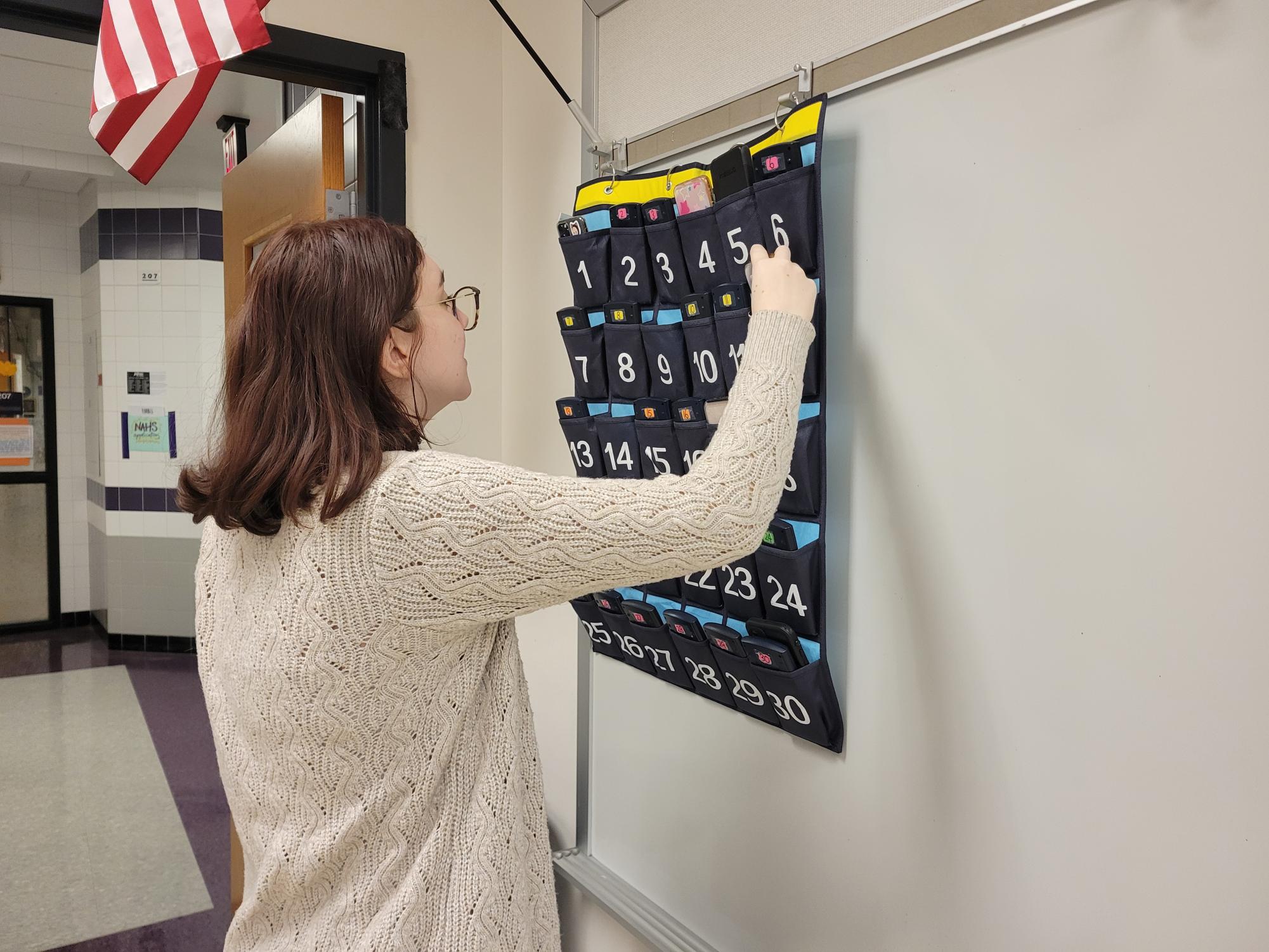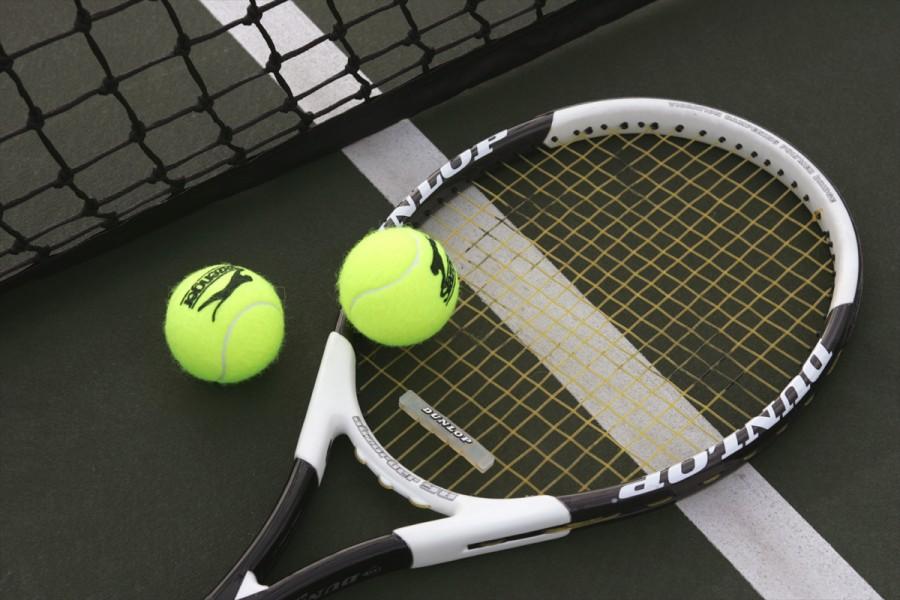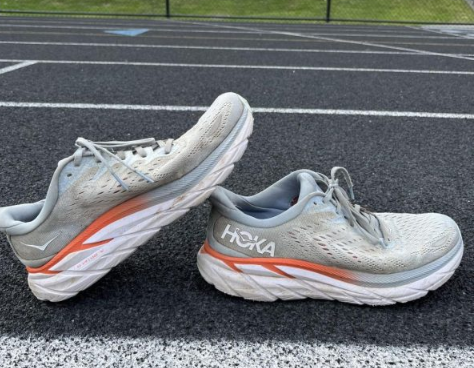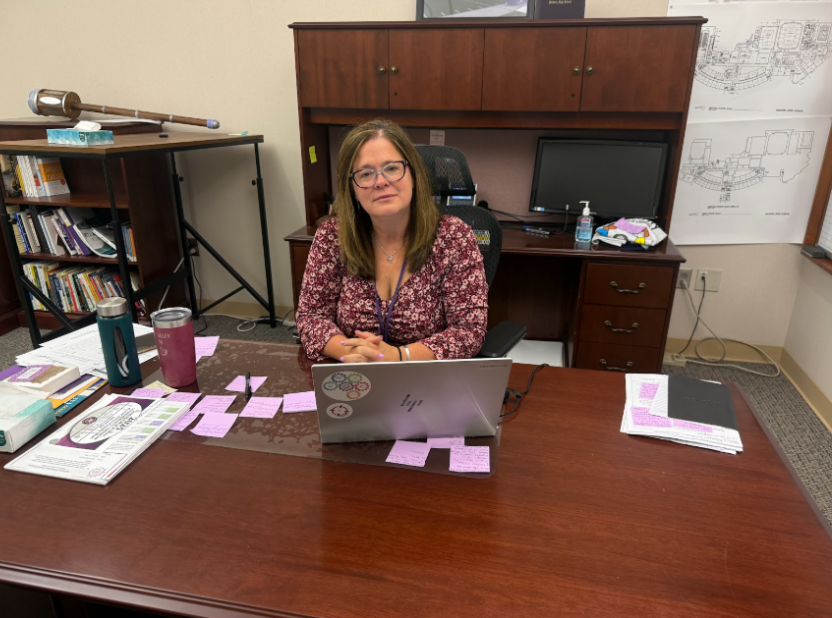Junior Grace Peebles has a standard routine every day in math class: She gets a calculator out of the caddy and leaves her phone in its place for the period.
“I take my calculator out of my assigned pocket and I leave my phone instead,” Peebles said. “I feel like it’s a system that works.”
Cell phone regulations are becoming increasingly more common, with the New York Times reporting that at least eight states have adopted rules to slow cell phone use during school hours.
At Baldwin, teachers were given phone caddies at the start of the year and were instructed to have every student put their phone in a pocket during instruction. Students can still use their phones at lunch and in the hallways.
Principal Shaun Tomaszewski said the goal is to minimize distractions in the classroom and help students stay on task.
“The calculator caddie conversation began last year,” he said. “It was really centered around attempting to short-circuit the disruptive impact that cell phones were having in classes during instructional time.”
While the caddie plan doesn’t bother some students, others said they feel uneasy without their phones. Considering the increasing rate of school violence, the inability to contact a parent in the case of an emergency makes some students feel unsafe, these students said.
“If something happens, you can’t get to your phone right away, or if something happens while you’re in the bathroom, you can’t contact anyone since you can’t have your phone in there,” sophomore Lara Al Imam said.
Safety is also a concern for junior Laila Goe. In a time when violence in schools is so prevalent, she thinks that phones are an important tool for communication.
“If something happens, teachers’ first thoughts aren’t to give students’ phones back. Then you would have no contact with the outside world,” Goe said. “I want to be able to say something to my family and friends if something happens.”
Jerad Smith, an educator with the school’s Chill Room, which is run through Allegheny Health Network, knows about students’ safety concerns, but he does not think that not having a phone would be a problem in an emergency.
“It maybe would delay some communication, but ultimately parents and guardians know where you’re at,” Smith said.
In fact, a year ago, Smith started requiring students to put their phones in a caddy when they enter the Chill Room.
“It’s cut down on kids who maybe want to come into the room but don’t have a reason to be here,” Smith said.
In terms of mental health, all the screen use is probably having negative effects on peoples’ brains, Smith said. Platforms like TikTok and Instagram are curated to appeal to short attention spans, with rapid and fast-paced content.
“I engage with it myself too, where I find myself scrolling through these reels and they’re quick,” Smith said.
Psychologists across the country have agreed that phones are a large factor in people’s mental health issues.
“The use of cell phones specifically, and social media in particular, has changed life for all of us,” Duke University psychology professor Timothy Strauman said. “Our lives are now busier, more crowded, and more demanding. But we also are in much better communication with one another. So there are both advantages and disadvantages to having phones always with us.”
Sophomore Allison Stewart agrees.
Social media can help people “recognize problems going on in the world, and advocate for those problems,” Stewart said.
But negatives, such as seeing others’ seemingly perfect online lives, could cause harm, Stewart said.
According to the Columbia University Department of Psychiatry, phone addiction is closely associated with mental health disorders and unhealthy behavior. Tomaszewski has seen the damage that can occur because of excessive phone use and social media.
“I see, as a high school principal, the negative impacts that cell phones have on kid’s lives,” he said. “We have kids who are engaging in self-harm behaviors because they’re glamorized by these horrible human beings who are making money off teenage mental health disorders.”
Some districts have gone further than Baldwin, banning phone use by students throughout the entire school day. These districts sometimes have students start the school day by locking their phones in a Yondr pouch, which can only be opened by a school official with a special magnetic key at the end of the day.
Social psychologist Jonathan Haidt, author of bestselling book The Anxious Generation, believes that schools should go phone-free for the entire school day.
“When schools go phone-free, this is what always seems to happen: Kids spend far more time talking to each other, playing, and laughing. School is more fun, and, as a side benefit, they learn more,” Haidt said.
At Baldwin, Tomaszewki said a complete phone ban is not needed.
“I really appreciated what (Haidt) put forward in The Anxious Generation,” Tomaszewski said. “I think, too, that responses should be proportionate and targeted to the challenges they’re addressing. If I thought that cell phones were so pernicious at the school level that we needed to prohibit any and all access to them throughout the day, then we’d be having a different conversation.”
Strauman, meanwhile, believes that phone caddies in schools are worth trying.
“I’m sure they aren’t perfect, but at least they are worth a try. I see them as less drastic than complete bans,” he said.
Besides, he said, trying to ban phone use all day probably would not succeed.
“I don’t think the bans are workable, and I won’t be surprised if it turns out that they generate a lot of lawsuits and legal actions,” Strauman said.

















